Business Analysis on Indian Government: Tools and Usage
VerifiedAdded on 2022/06/07
|17
|2799
|24
Report
AI Summary
This research paper conducts a comprehensive business analysis of the Indian government structure, evaluating its organizational design through various analytical tools. It begins with an overview of analytical methods, including the Expanded 7-S Framework, Balanced Scorecard, SWOT, and PESTLE analysis, detailing their application, merits, and shortcomings. The paper then applies these models to the Indian government's organizational structure, identifying specific variables and drawing conclusions. The SWOT analysis examines strengths, weaknesses, opportunities, and threats. PESTEL analysis assesses political, economic, social, technological, environmental, and legal factors. The McKinsey 7S framework evaluates structure, strategy, skill, system, shared values, style, and staff. The balanced scorecard is used to prioritize products and express goals. The study aims to provide insights into the effectiveness of these tools in analyzing and improving the Indian government's operational efficiency and strategic planning, with references to relevant literature.
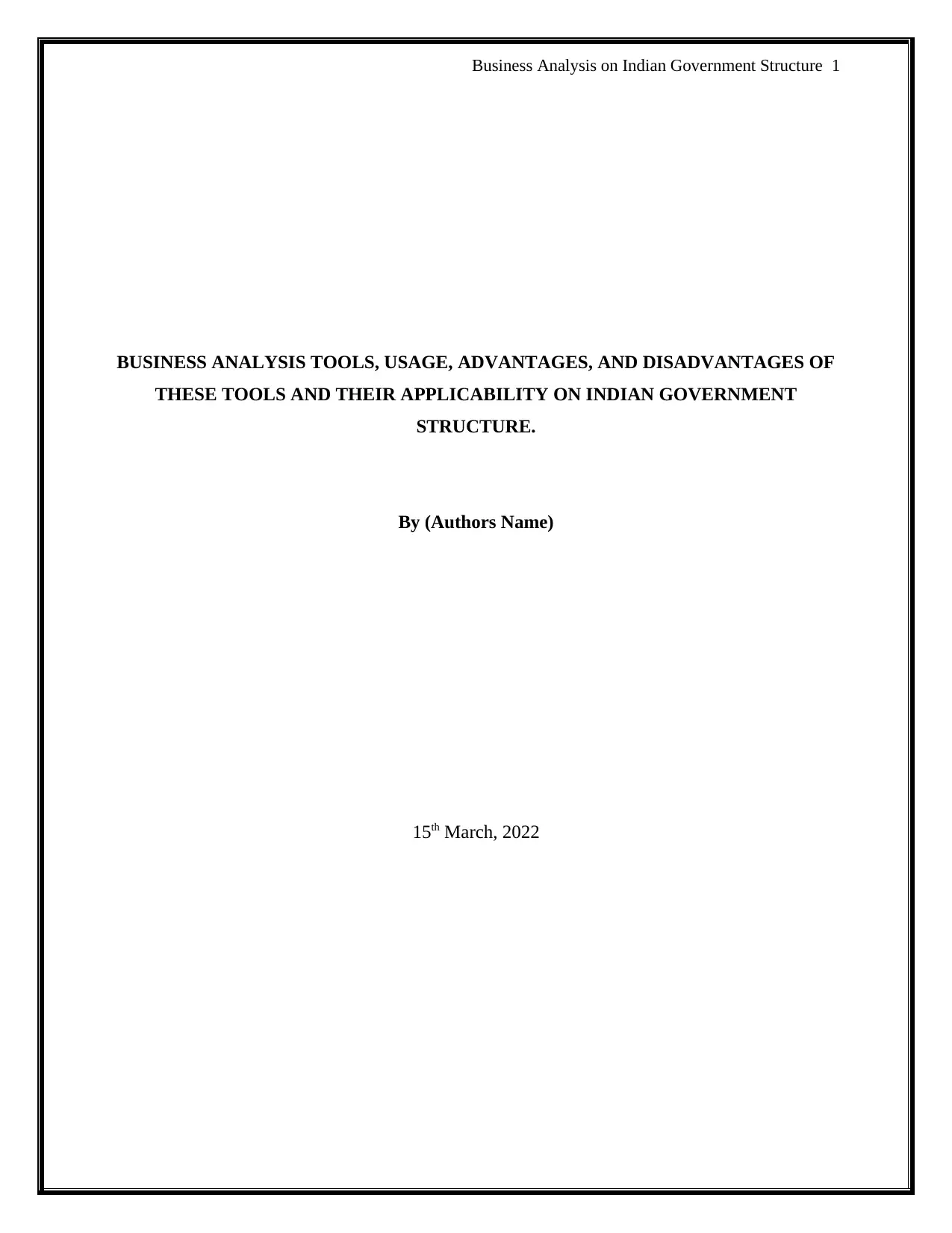
Business Analysis on Indian Government Structure 1
BUSINESS ANALYSIS TOOLS, USAGE, ADVANTAGES, AND DISADVANTAGES OF
THESE TOOLS AND THEIR APPLICABILITY ON INDIAN GOVERNMENT
STRUCTURE.
By (Authors Name)
15th March, 2022
BUSINESS ANALYSIS TOOLS, USAGE, ADVANTAGES, AND DISADVANTAGES OF
THESE TOOLS AND THEIR APPLICABILITY ON INDIAN GOVERNMENT
STRUCTURE.
By (Authors Name)
15th March, 2022
Paraphrase This Document
Need a fresh take? Get an instant paraphrase of this document with our AI Paraphraser
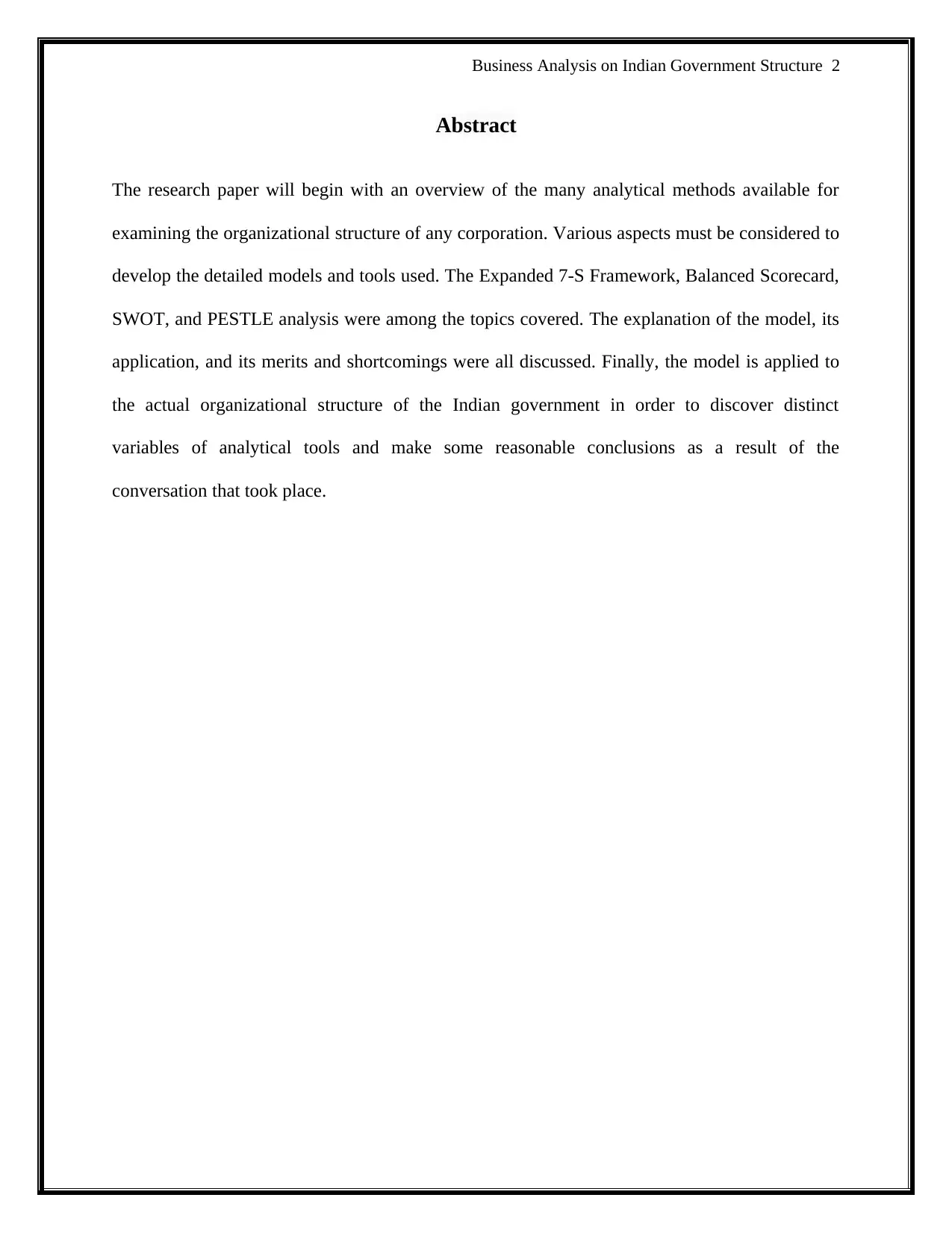
Business Analysis on Indian Government Structure 2
Abstract
The research paper will begin with an overview of the many analytical methods available for
examining the organizational structure of any corporation. Various aspects must be considered to
develop the detailed models and tools used. The Expanded 7-S Framework, Balanced Scorecard,
SWOT, and PESTLE analysis were among the topics covered. The explanation of the model, its
application, and its merits and shortcomings were all discussed. Finally, the model is applied to
the actual organizational structure of the Indian government in order to discover distinct
variables of analytical tools and make some reasonable conclusions as a result of the
conversation that took place.
Abstract
The research paper will begin with an overview of the many analytical methods available for
examining the organizational structure of any corporation. Various aspects must be considered to
develop the detailed models and tools used. The Expanded 7-S Framework, Balanced Scorecard,
SWOT, and PESTLE analysis were among the topics covered. The explanation of the model, its
application, and its merits and shortcomings were all discussed. Finally, the model is applied to
the actual organizational structure of the Indian government in order to discover distinct
variables of analytical tools and make some reasonable conclusions as a result of the
conversation that took place.
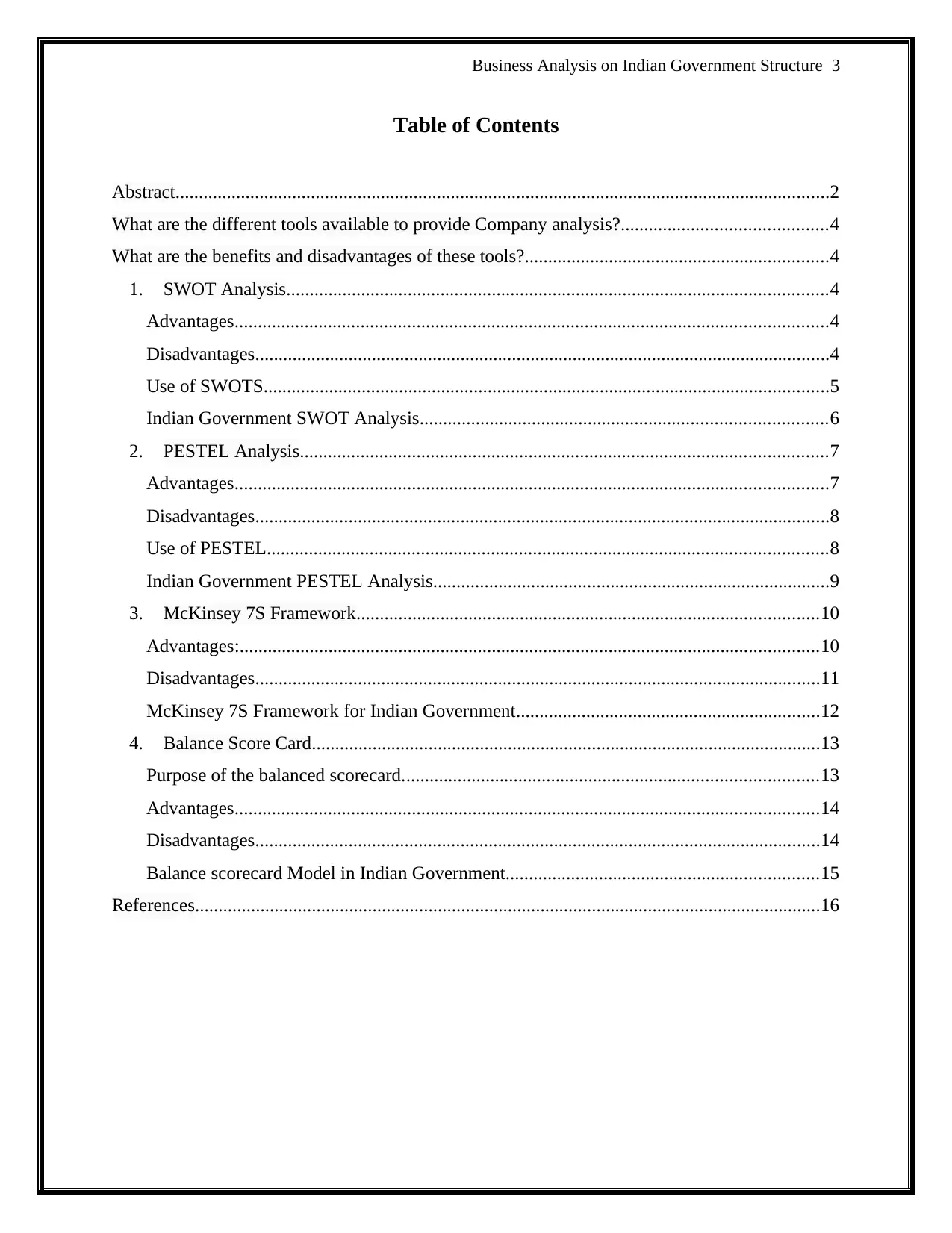
Business Analysis on Indian Government Structure 3
Table of Contents
Abstract............................................................................................................................................2
What are the different tools available to provide Company analysis?............................................4
What are the benefits and disadvantages of these tools?.................................................................4
1. SWOT Analysis....................................................................................................................4
Advantages...............................................................................................................................4
Disadvantages...........................................................................................................................4
Use of SWOTS.........................................................................................................................5
Indian Government SWOT Analysis.......................................................................................6
2. PESTEL Analysis.................................................................................................................7
Advantages...............................................................................................................................7
Disadvantages...........................................................................................................................8
Use of PESTEL........................................................................................................................8
Indian Government PESTEL Analysis.....................................................................................9
3. McKinsey 7S Framework...................................................................................................10
Advantages:............................................................................................................................10
Disadvantages.........................................................................................................................11
McKinsey 7S Framework for Indian Government.................................................................12
4. Balance Score Card.............................................................................................................13
Purpose of the balanced scorecard.........................................................................................13
Advantages.............................................................................................................................14
Disadvantages.........................................................................................................................14
Balance scorecard Model in Indian Government...................................................................15
References......................................................................................................................................16
Table of Contents
Abstract............................................................................................................................................2
What are the different tools available to provide Company analysis?............................................4
What are the benefits and disadvantages of these tools?.................................................................4
1. SWOT Analysis....................................................................................................................4
Advantages...............................................................................................................................4
Disadvantages...........................................................................................................................4
Use of SWOTS.........................................................................................................................5
Indian Government SWOT Analysis.......................................................................................6
2. PESTEL Analysis.................................................................................................................7
Advantages...............................................................................................................................7
Disadvantages...........................................................................................................................8
Use of PESTEL........................................................................................................................8
Indian Government PESTEL Analysis.....................................................................................9
3. McKinsey 7S Framework...................................................................................................10
Advantages:............................................................................................................................10
Disadvantages.........................................................................................................................11
McKinsey 7S Framework for Indian Government.................................................................12
4. Balance Score Card.............................................................................................................13
Purpose of the balanced scorecard.........................................................................................13
Advantages.............................................................................................................................14
Disadvantages.........................................................................................................................14
Balance scorecard Model in Indian Government...................................................................15
References......................................................................................................................................16
⊘ This is a preview!⊘
Do you want full access?
Subscribe today to unlock all pages.

Trusted by 1+ million students worldwide
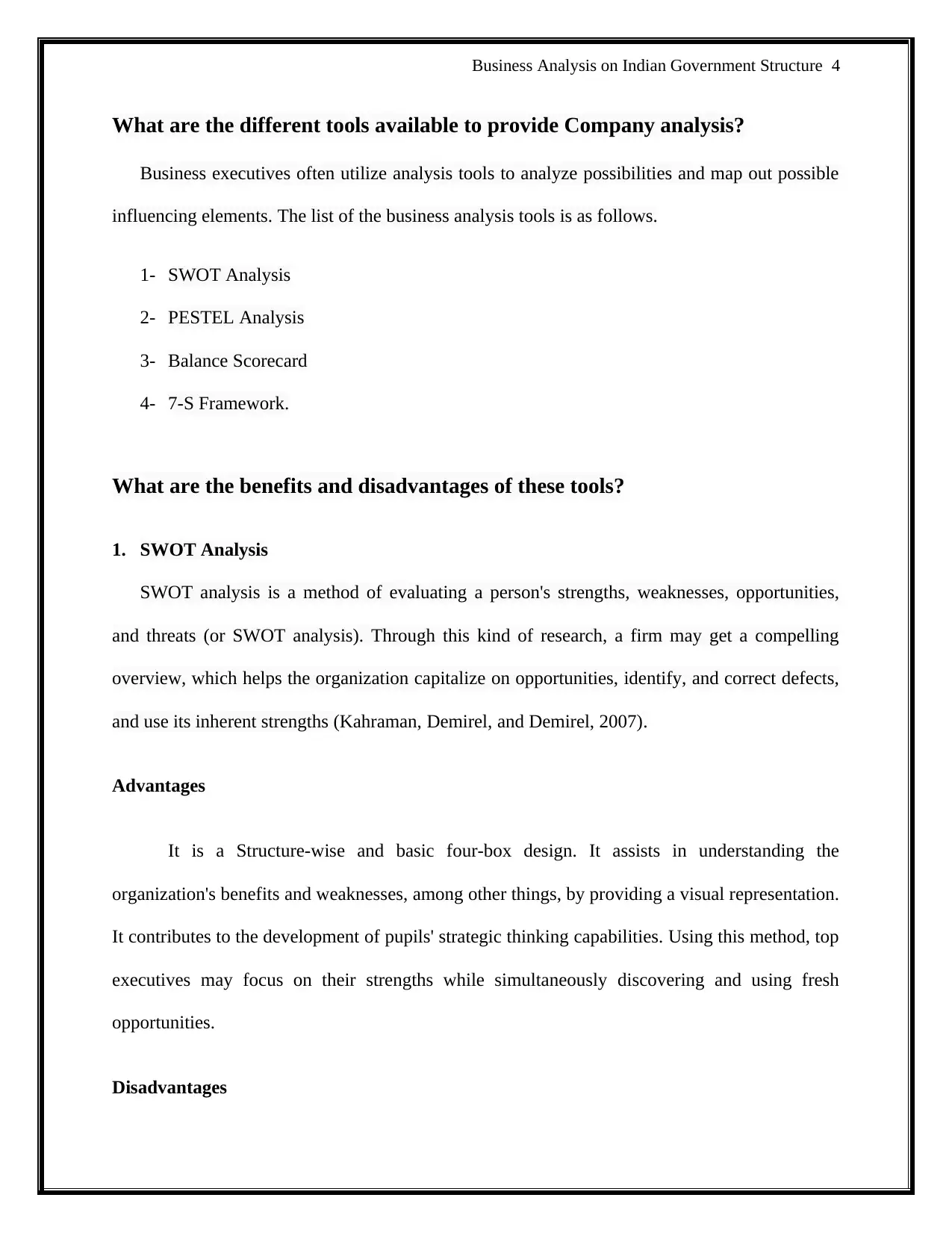
Business Analysis on Indian Government Structure 4
What are the different tools available to provide Company analysis?
Business executives often utilize analysis tools to analyze possibilities and map out possible
influencing elements. The list of the business analysis tools is as follows.
1- SWOT Analysis
2- PESTEL Analysis
3- Balance Scorecard
4- 7-S Framework.
What are the benefits and disadvantages of these tools?
1. SWOT Analysis
SWOT analysis is a method of evaluating a person's strengths, weaknesses, opportunities,
and threats (or SWOT analysis). Through this kind of research, a firm may get a compelling
overview, which helps the organization capitalize on opportunities, identify, and correct defects,
and use its inherent strengths (Kahraman, Demirel, and Demirel, 2007).
Advantages
It is a Structure-wise and basic four-box design. It assists in understanding the
organization's benefits and weaknesses, among other things, by providing a visual representation.
It contributes to the development of pupils' strategic thinking capabilities. Using this method, top
executives may focus on their strengths while simultaneously discovering and using fresh
opportunities.
Disadvantages
What are the different tools available to provide Company analysis?
Business executives often utilize analysis tools to analyze possibilities and map out possible
influencing elements. The list of the business analysis tools is as follows.
1- SWOT Analysis
2- PESTEL Analysis
3- Balance Scorecard
4- 7-S Framework.
What are the benefits and disadvantages of these tools?
1. SWOT Analysis
SWOT analysis is a method of evaluating a person's strengths, weaknesses, opportunities,
and threats (or SWOT analysis). Through this kind of research, a firm may get a compelling
overview, which helps the organization capitalize on opportunities, identify, and correct defects,
and use its inherent strengths (Kahraman, Demirel, and Demirel, 2007).
Advantages
It is a Structure-wise and basic four-box design. It assists in understanding the
organization's benefits and weaknesses, among other things, by providing a visual representation.
It contributes to the development of pupils' strategic thinking capabilities. Using this method, top
executives may focus on their strengths while simultaneously discovering and using fresh
opportunities.
Disadvantages
Paraphrase This Document
Need a fresh take? Get an instant paraphrase of this document with our AI Paraphraser
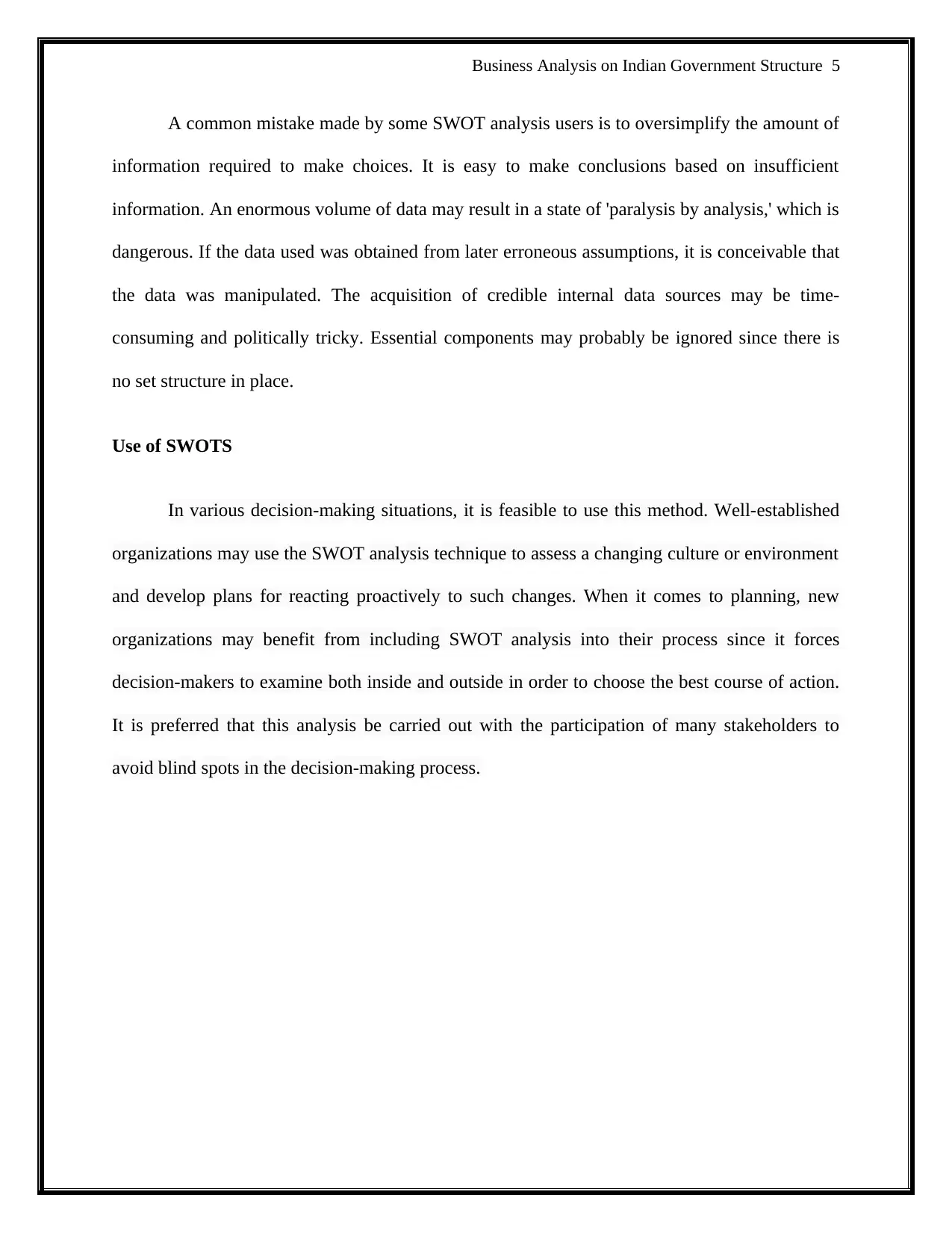
Business Analysis on Indian Government Structure 5
A common mistake made by some SWOT analysis users is to oversimplify the amount of
information required to make choices. It is easy to make conclusions based on insufficient
information. An enormous volume of data may result in a state of 'paralysis by analysis,' which is
dangerous. If the data used was obtained from later erroneous assumptions, it is conceivable that
the data was manipulated. The acquisition of credible internal data sources may be time-
consuming and politically tricky. Essential components may probably be ignored since there is
no set structure in place.
Use of SWOTS
In various decision-making situations, it is feasible to use this method. Well-established
organizations may use the SWOT analysis technique to assess a changing culture or environment
and develop plans for reacting proactively to such changes. When it comes to planning, new
organizations may benefit from including SWOT analysis into their process since it forces
decision-makers to examine both inside and outside in order to choose the best course of action.
It is preferred that this analysis be carried out with the participation of many stakeholders to
avoid blind spots in the decision-making process.
A common mistake made by some SWOT analysis users is to oversimplify the amount of
information required to make choices. It is easy to make conclusions based on insufficient
information. An enormous volume of data may result in a state of 'paralysis by analysis,' which is
dangerous. If the data used was obtained from later erroneous assumptions, it is conceivable that
the data was manipulated. The acquisition of credible internal data sources may be time-
consuming and politically tricky. Essential components may probably be ignored since there is
no set structure in place.
Use of SWOTS
In various decision-making situations, it is feasible to use this method. Well-established
organizations may use the SWOT analysis technique to assess a changing culture or environment
and develop plans for reacting proactively to such changes. When it comes to planning, new
organizations may benefit from including SWOT analysis into their process since it forces
decision-makers to examine both inside and outside in order to choose the best course of action.
It is preferred that this analysis be carried out with the participation of many stakeholders to
avoid blind spots in the decision-making process.
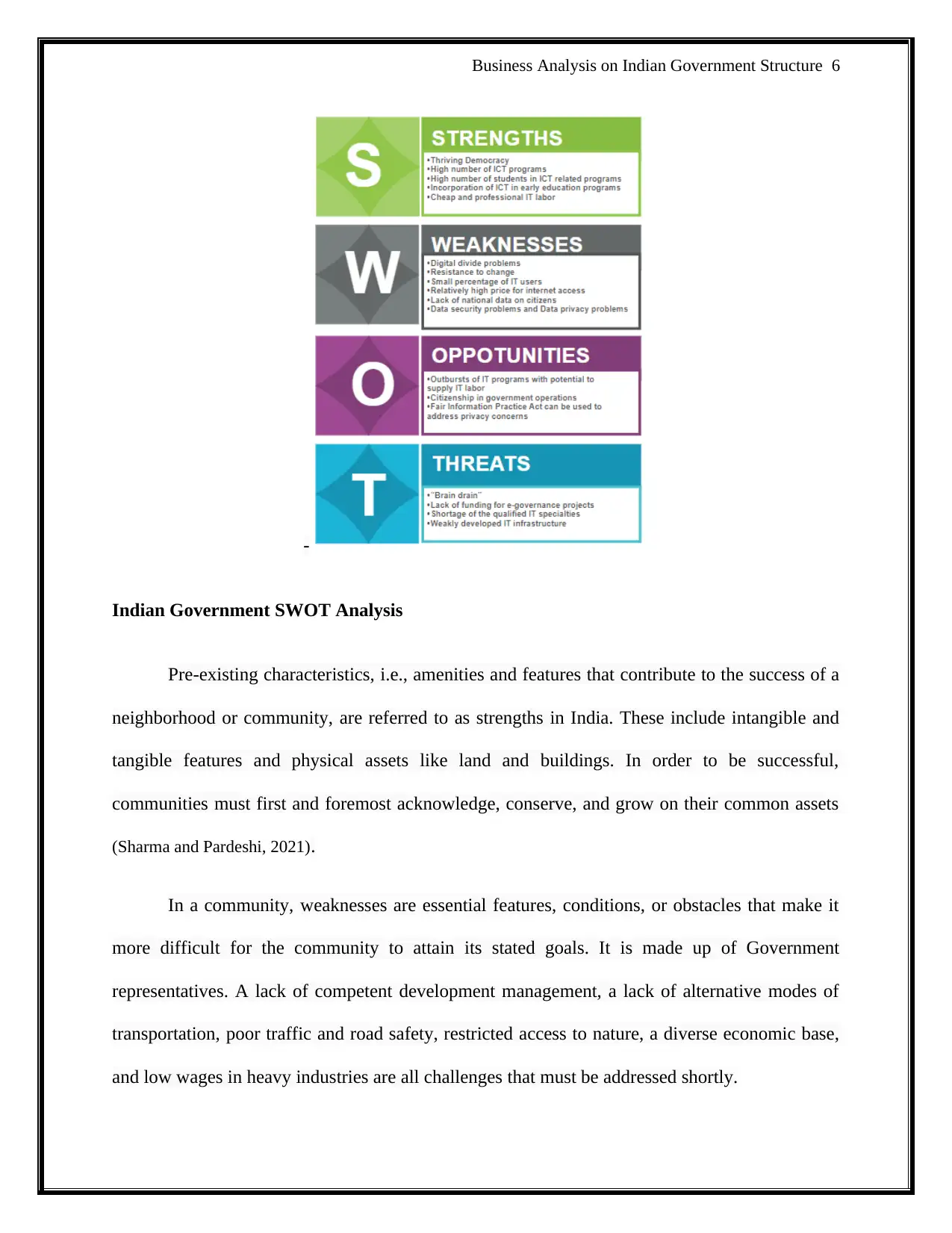
Business Analysis on Indian Government Structure 6
-
Indian Government SWOT Analysis
Pre-existing characteristics, i.e., amenities and features that contribute to the success of a
neighborhood or community, are referred to as strengths in India. These include intangible and
tangible features and physical assets like land and buildings. In order to be successful,
communities must first and foremost acknowledge, conserve, and grow on their common assets
(Sharma and Pardeshi, 2021).
In a community, weaknesses are essential features, conditions, or obstacles that make it
more difficult for the community to attain its stated goals. It is made up of Government
representatives. A lack of competent development management, a lack of alternative modes of
transportation, poor traffic and road safety, restricted access to nature, a diverse economic base,
and low wages in heavy industries are all challenges that must be addressed shortly.
-
Indian Government SWOT Analysis
Pre-existing characteristics, i.e., amenities and features that contribute to the success of a
neighborhood or community, are referred to as strengths in India. These include intangible and
tangible features and physical assets like land and buildings. In order to be successful,
communities must first and foremost acknowledge, conserve, and grow on their common assets
(Sharma and Pardeshi, 2021).
In a community, weaknesses are essential features, conditions, or obstacles that make it
more difficult for the community to attain its stated goals. It is made up of Government
representatives. A lack of competent development management, a lack of alternative modes of
transportation, poor traffic and road safety, restricted access to nature, a diverse economic base,
and low wages in heavy industries are all challenges that must be addressed shortly.
⊘ This is a preview!⊘
Do you want full access?
Subscribe today to unlock all pages.

Trusted by 1+ million students worldwide
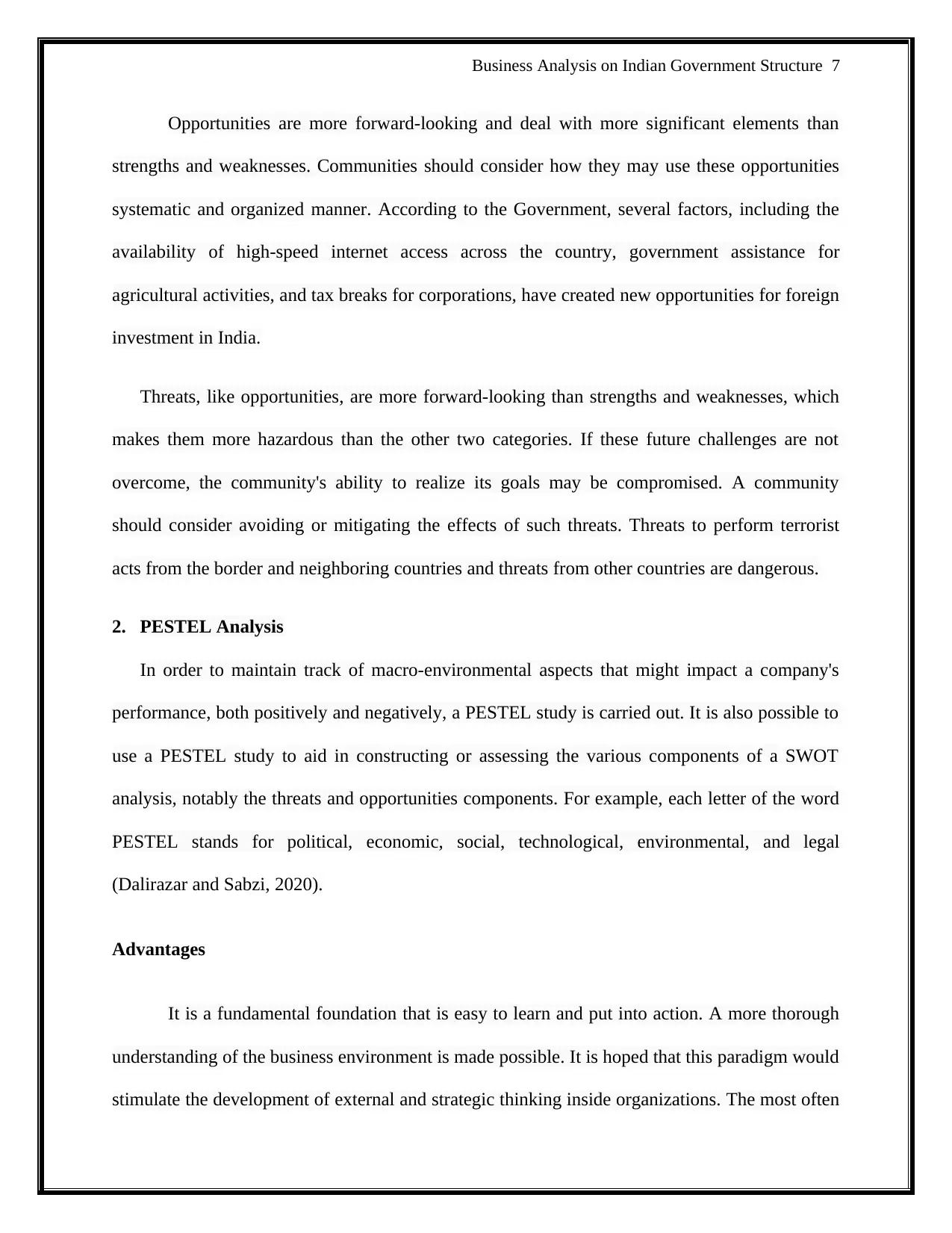
Business Analysis on Indian Government Structure 7
Opportunities are more forward-looking and deal with more significant elements than
strengths and weaknesses. Communities should consider how they may use these opportunities
systematic and organized manner. According to the Government, several factors, including the
availability of high-speed internet access across the country, government assistance for
agricultural activities, and tax breaks for corporations, have created new opportunities for foreign
investment in India.
Threats, like opportunities, are more forward-looking than strengths and weaknesses, which
makes them more hazardous than the other two categories. If these future challenges are not
overcome, the community's ability to realize its goals may be compromised. A community
should consider avoiding or mitigating the effects of such threats. Threats to perform terrorist
acts from the border and neighboring countries and threats from other countries are dangerous.
2. PESTEL Analysis
In order to maintain track of macro-environmental aspects that might impact a company's
performance, both positively and negatively, a PESTEL study is carried out. It is also possible to
use a PESTEL study to aid in constructing or assessing the various components of a SWOT
analysis, notably the threats and opportunities components. For example, each letter of the word
PESTEL stands for political, economic, social, technological, environmental, and legal
(Dalirazar and Sabzi, 2020).
Advantages
It is a fundamental foundation that is easy to learn and put into action. A more thorough
understanding of the business environment is made possible. It is hoped that this paradigm would
stimulate the development of external and strategic thinking inside organizations. The most often
Opportunities are more forward-looking and deal with more significant elements than
strengths and weaknesses. Communities should consider how they may use these opportunities
systematic and organized manner. According to the Government, several factors, including the
availability of high-speed internet access across the country, government assistance for
agricultural activities, and tax breaks for corporations, have created new opportunities for foreign
investment in India.
Threats, like opportunities, are more forward-looking than strengths and weaknesses, which
makes them more hazardous than the other two categories. If these future challenges are not
overcome, the community's ability to realize its goals may be compromised. A community
should consider avoiding or mitigating the effects of such threats. Threats to perform terrorist
acts from the border and neighboring countries and threats from other countries are dangerous.
2. PESTEL Analysis
In order to maintain track of macro-environmental aspects that might impact a company's
performance, both positively and negatively, a PESTEL study is carried out. It is also possible to
use a PESTEL study to aid in constructing or assessing the various components of a SWOT
analysis, notably the threats and opportunities components. For example, each letter of the word
PESTEL stands for political, economic, social, technological, environmental, and legal
(Dalirazar and Sabzi, 2020).
Advantages
It is a fundamental foundation that is easy to learn and put into action. A more thorough
understanding of the business environment is made possible. It is hoped that this paradigm would
stimulate the development of external and strategic thinking inside organizations. The most often
Paraphrase This Document
Need a fresh take? Get an instant paraphrase of this document with our AI Paraphraser
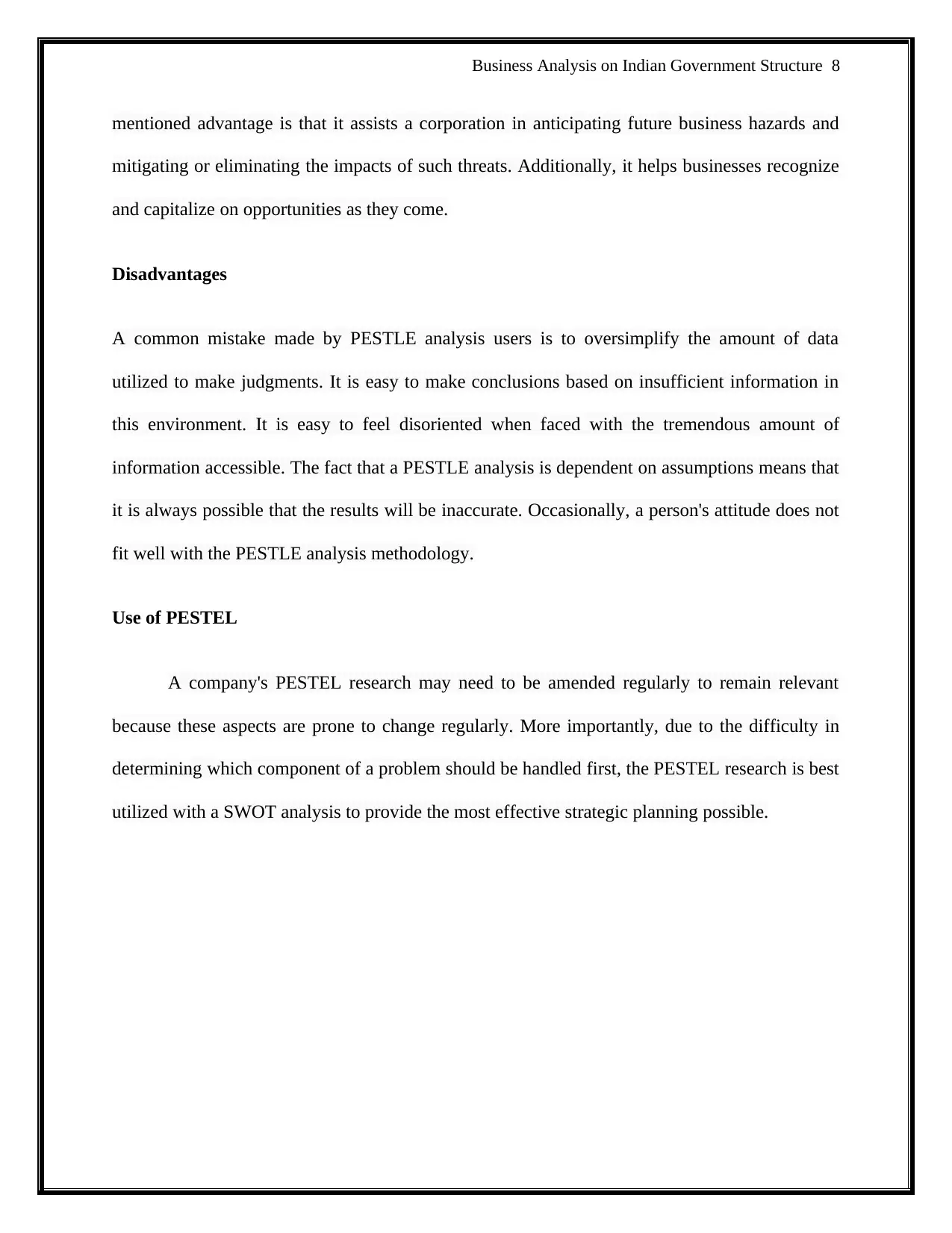
Business Analysis on Indian Government Structure 8
mentioned advantage is that it assists a corporation in anticipating future business hazards and
mitigating or eliminating the impacts of such threats. Additionally, it helps businesses recognize
and capitalize on opportunities as they come.
Disadvantages
A common mistake made by PESTLE analysis users is to oversimplify the amount of data
utilized to make judgments. It is easy to make conclusions based on insufficient information in
this environment. It is easy to feel disoriented when faced with the tremendous amount of
information accessible. The fact that a PESTLE analysis is dependent on assumptions means that
it is always possible that the results will be inaccurate. Occasionally, a person's attitude does not
fit well with the PESTLE analysis methodology.
Use of PESTEL
A company's PESTEL research may need to be amended regularly to remain relevant
because these aspects are prone to change regularly. More importantly, due to the difficulty in
determining which component of a problem should be handled first, the PESTEL research is best
utilized with a SWOT analysis to provide the most effective strategic planning possible.
mentioned advantage is that it assists a corporation in anticipating future business hazards and
mitigating or eliminating the impacts of such threats. Additionally, it helps businesses recognize
and capitalize on opportunities as they come.
Disadvantages
A common mistake made by PESTLE analysis users is to oversimplify the amount of data
utilized to make judgments. It is easy to make conclusions based on insufficient information in
this environment. It is easy to feel disoriented when faced with the tremendous amount of
information accessible. The fact that a PESTLE analysis is dependent on assumptions means that
it is always possible that the results will be inaccurate. Occasionally, a person's attitude does not
fit well with the PESTLE analysis methodology.
Use of PESTEL
A company's PESTEL research may need to be amended regularly to remain relevant
because these aspects are prone to change regularly. More importantly, due to the difficulty in
determining which component of a problem should be handled first, the PESTEL research is best
utilized with a SWOT analysis to provide the most effective strategic planning possible.
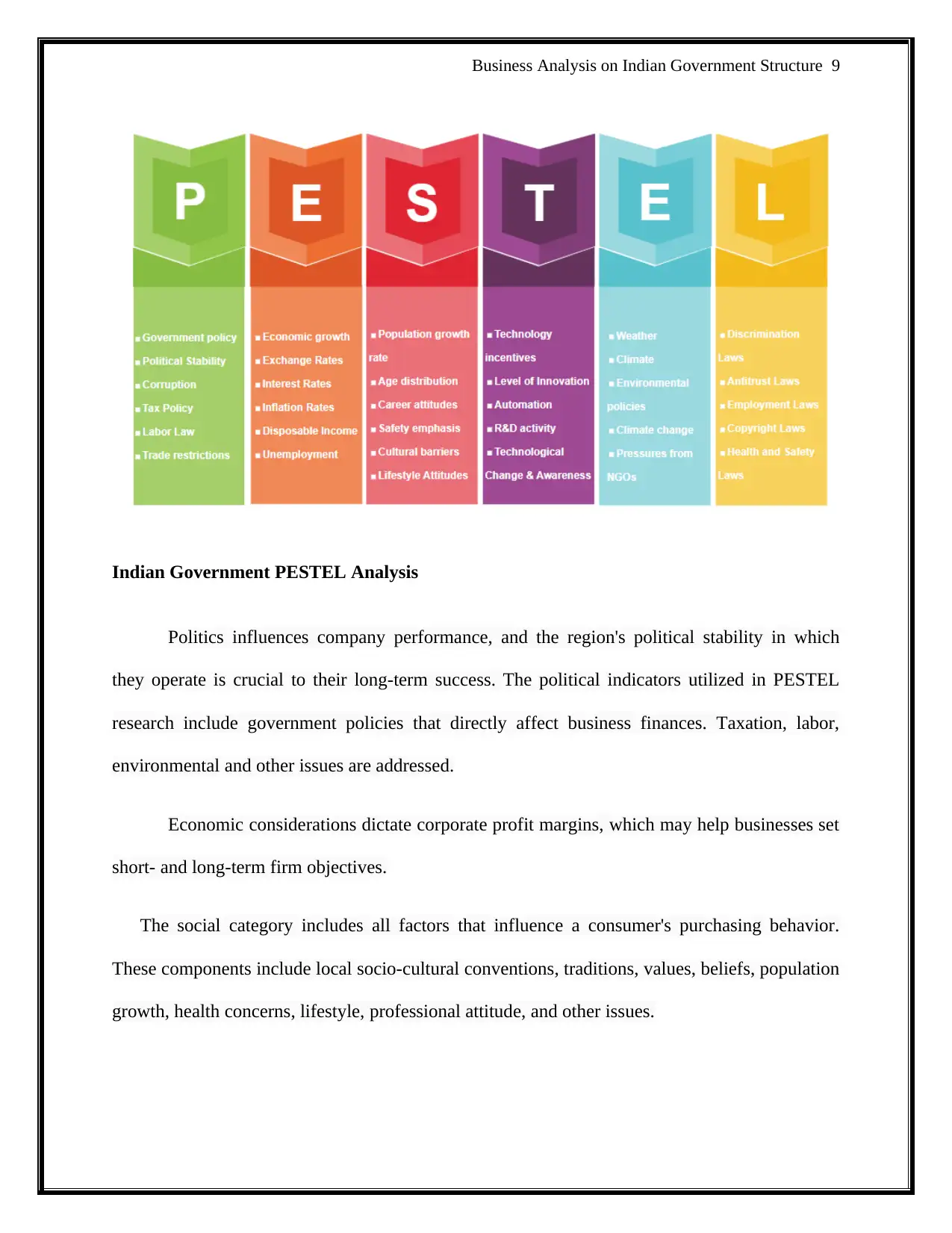
Business Analysis on Indian Government Structure 9
Indian Government PESTEL Analysis
Politics influences company performance, and the region's political stability in which
they operate is crucial to their long-term success. The political indicators utilized in PESTEL
research include government policies that directly affect business finances. Taxation, labor,
environmental and other issues are addressed.
Economic considerations dictate corporate profit margins, which may help businesses set
short- and long-term firm objectives.
The social category includes all factors that influence a consumer's purchasing behavior.
These components include local socio-cultural conventions, traditions, values, beliefs, population
growth, health concerns, lifestyle, professional attitude, and other issues.
Indian Government PESTEL Analysis
Politics influences company performance, and the region's political stability in which
they operate is crucial to their long-term success. The political indicators utilized in PESTEL
research include government policies that directly affect business finances. Taxation, labor,
environmental and other issues are addressed.
Economic considerations dictate corporate profit margins, which may help businesses set
short- and long-term firm objectives.
The social category includes all factors that influence a consumer's purchasing behavior.
These components include local socio-cultural conventions, traditions, values, beliefs, population
growth, health concerns, lifestyle, professional attitude, and other issues.
⊘ This is a preview!⊘
Do you want full access?
Subscribe today to unlock all pages.

Trusted by 1+ million students worldwide
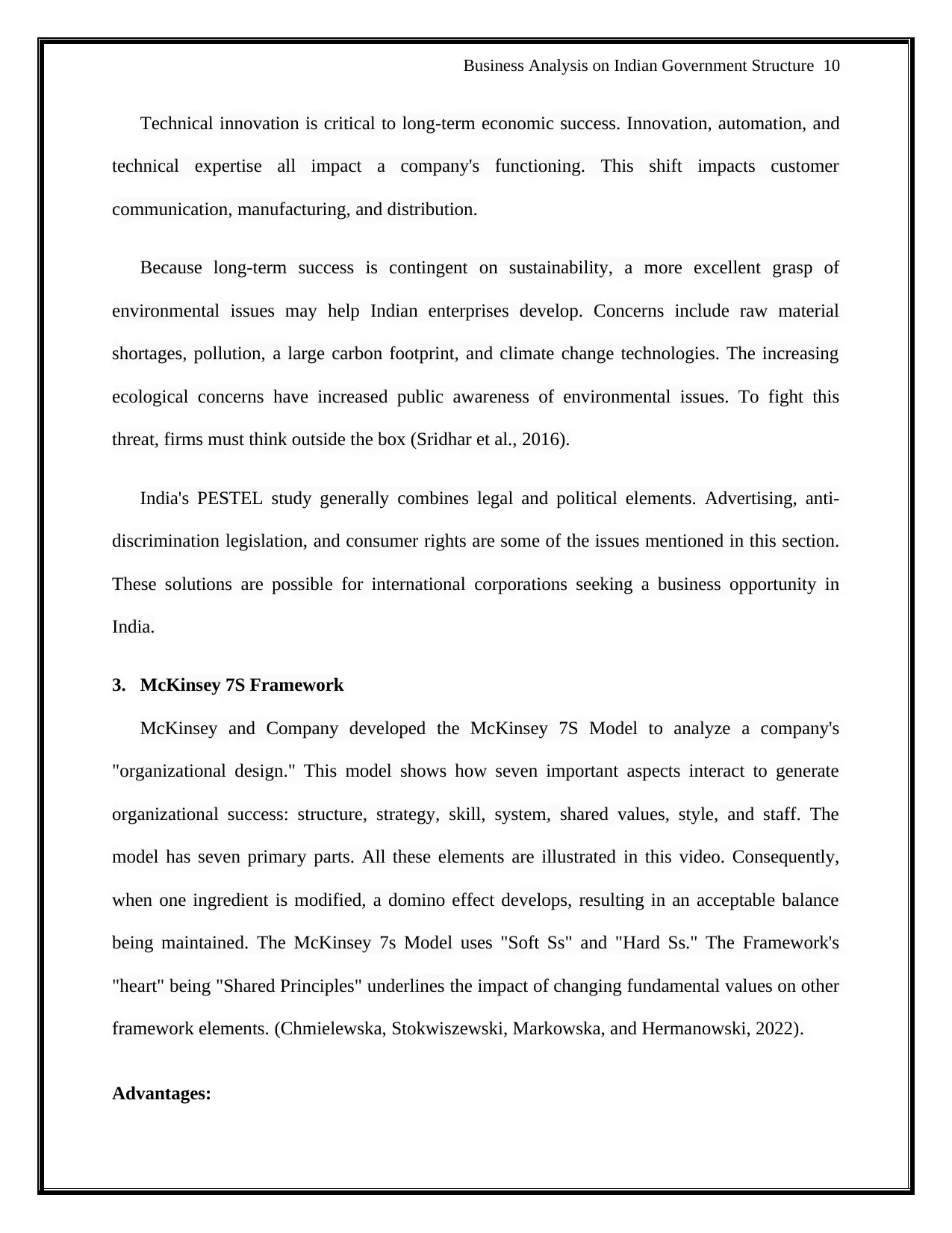
Business Analysis on Indian Government Structure 10
Technical innovation is critical to long-term economic success. Innovation, automation, and
technical expertise all impact a company's functioning. This shift impacts customer
communication, manufacturing, and distribution.
Because long-term success is contingent on sustainability, a more excellent grasp of
environmental issues may help Indian enterprises develop. Concerns include raw material
shortages, pollution, a large carbon footprint, and climate change technologies. The increasing
ecological concerns have increased public awareness of environmental issues. To fight this
threat, firms must think outside the box (Sridhar et al., 2016).
India's PESTEL study generally combines legal and political elements. Advertising, anti-
discrimination legislation, and consumer rights are some of the issues mentioned in this section.
These solutions are possible for international corporations seeking a business opportunity in
India.
3. McKinsey 7S Framework
McKinsey and Company developed the McKinsey 7S Model to analyze a company's
"organizational design." This model shows how seven important aspects interact to generate
organizational success: structure, strategy, skill, system, shared values, style, and staff. The
model has seven primary parts. All these elements are illustrated in this video. Consequently,
when one ingredient is modified, a domino effect develops, resulting in an acceptable balance
being maintained. The McKinsey 7s Model uses "Soft Ss" and "Hard Ss." The Framework's
"heart" being "Shared Principles" underlines the impact of changing fundamental values on other
framework elements. (Chmielewska, Stokwiszewski, Markowska, and Hermanowski, 2022).
Advantages:
Technical innovation is critical to long-term economic success. Innovation, automation, and
technical expertise all impact a company's functioning. This shift impacts customer
communication, manufacturing, and distribution.
Because long-term success is contingent on sustainability, a more excellent grasp of
environmental issues may help Indian enterprises develop. Concerns include raw material
shortages, pollution, a large carbon footprint, and climate change technologies. The increasing
ecological concerns have increased public awareness of environmental issues. To fight this
threat, firms must think outside the box (Sridhar et al., 2016).
India's PESTEL study generally combines legal and political elements. Advertising, anti-
discrimination legislation, and consumer rights are some of the issues mentioned in this section.
These solutions are possible for international corporations seeking a business opportunity in
India.
3. McKinsey 7S Framework
McKinsey and Company developed the McKinsey 7S Model to analyze a company's
"organizational design." This model shows how seven important aspects interact to generate
organizational success: structure, strategy, skill, system, shared values, style, and staff. The
model has seven primary parts. All these elements are illustrated in this video. Consequently,
when one ingredient is modified, a domino effect develops, resulting in an acceptable balance
being maintained. The McKinsey 7s Model uses "Soft Ss" and "Hard Ss." The Framework's
"heart" being "Shared Principles" underlines the impact of changing fundamental values on other
framework elements. (Chmielewska, Stokwiszewski, Markowska, and Hermanowski, 2022).
Advantages:
Paraphrase This Document
Need a fresh take? Get an instant paraphrase of this document with our AI Paraphraser
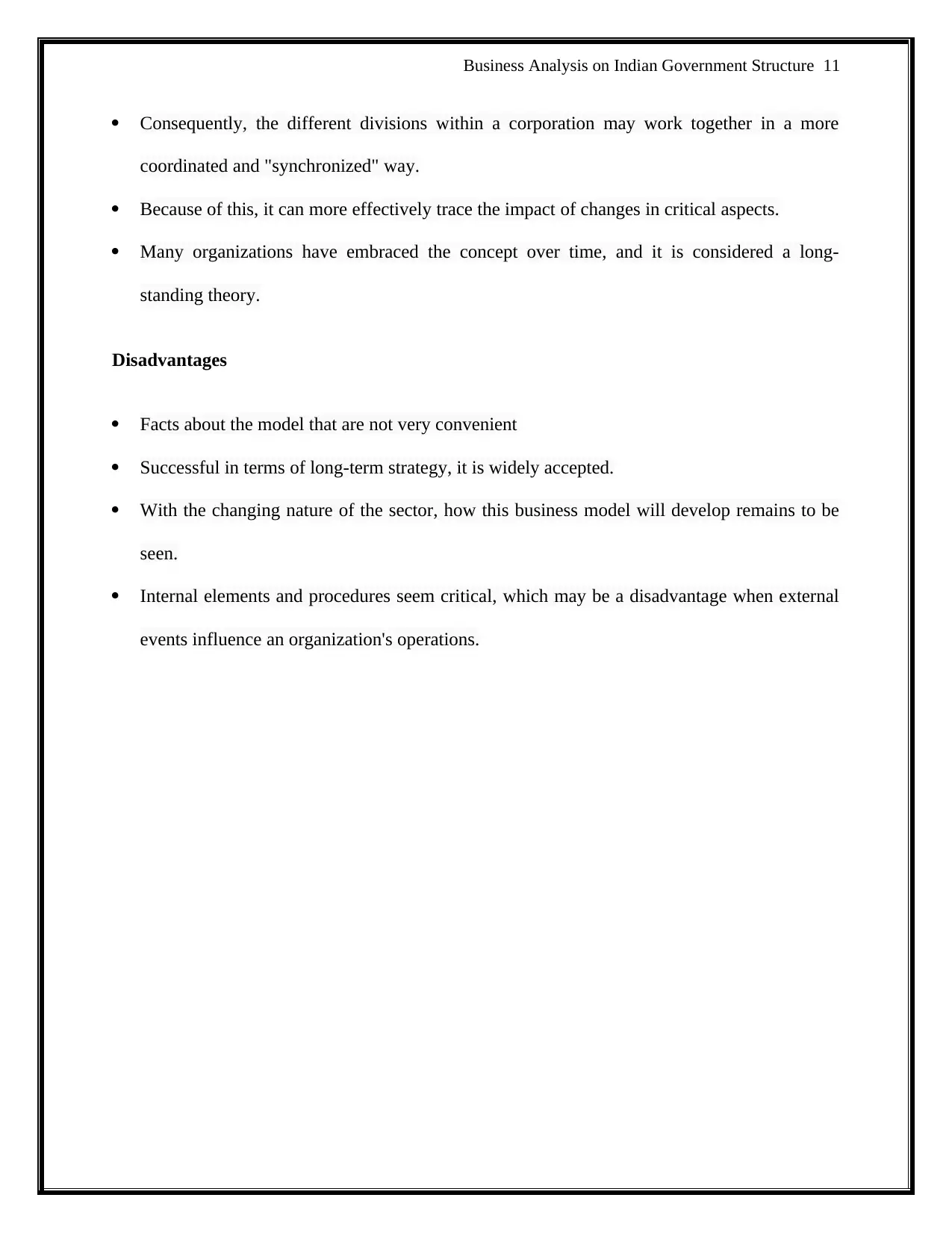
Business Analysis on Indian Government Structure 11
Consequently, the different divisions within a corporation may work together in a more
coordinated and "synchronized" way.
Because of this, it can more effectively trace the impact of changes in critical aspects.
Many organizations have embraced the concept over time, and it is considered a long-
standing theory.
Disadvantages
Facts about the model that are not very convenient
Successful in terms of long-term strategy, it is widely accepted.
With the changing nature of the sector, how this business model will develop remains to be
seen.
Internal elements and procedures seem critical, which may be a disadvantage when external
events influence an organization's operations.
Consequently, the different divisions within a corporation may work together in a more
coordinated and "synchronized" way.
Because of this, it can more effectively trace the impact of changes in critical aspects.
Many organizations have embraced the concept over time, and it is considered a long-
standing theory.
Disadvantages
Facts about the model that are not very convenient
Successful in terms of long-term strategy, it is widely accepted.
With the changing nature of the sector, how this business model will develop remains to be
seen.
Internal elements and procedures seem critical, which may be a disadvantage when external
events influence an organization's operations.
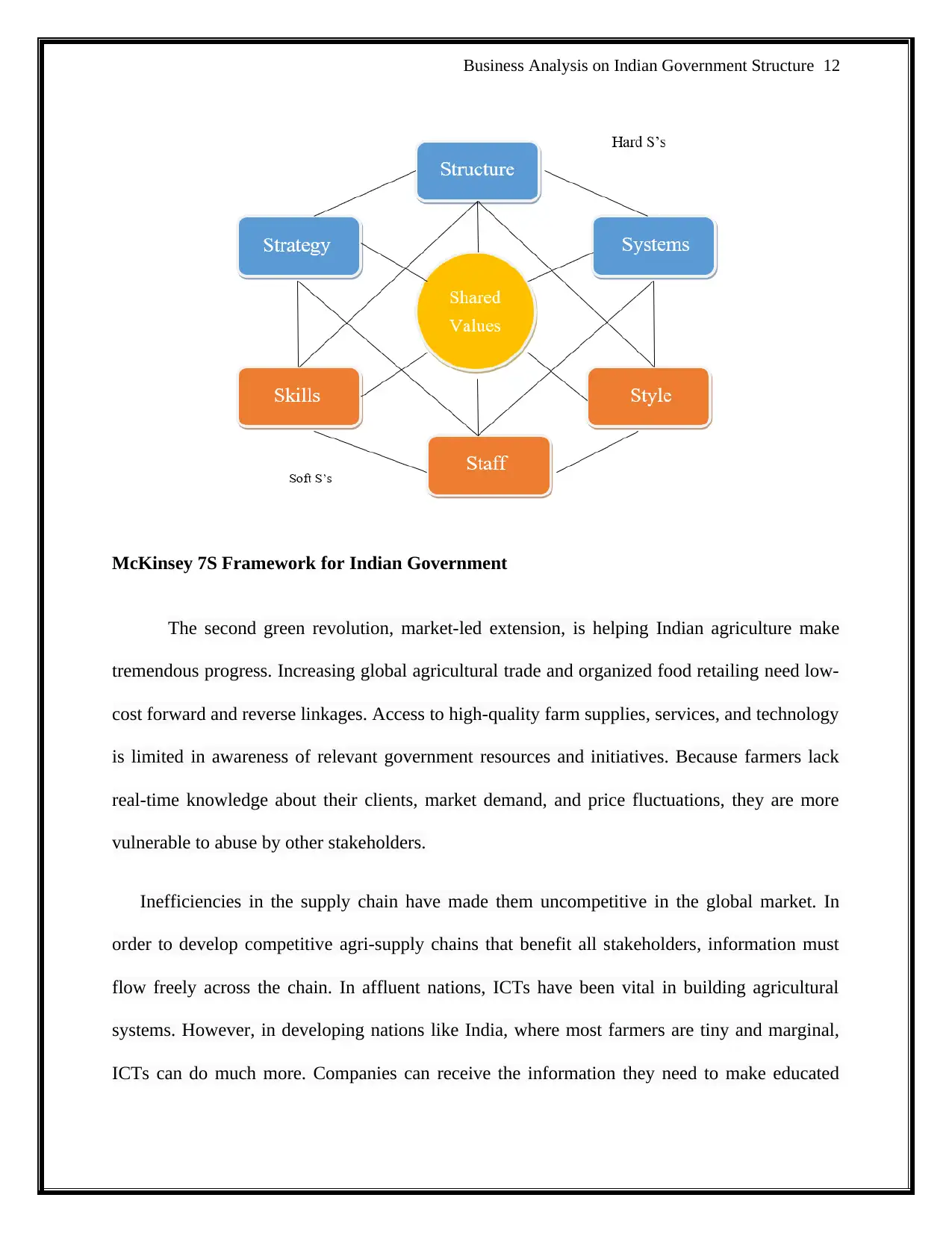
Business Analysis on Indian Government Structure 12
McKinsey 7S Framework for Indian Government
The second green revolution, market-led extension, is helping Indian agriculture make
tremendous progress. Increasing global agricultural trade and organized food retailing need low-
cost forward and reverse linkages. Access to high-quality farm supplies, services, and technology
is limited in awareness of relevant government resources and initiatives. Because farmers lack
real-time knowledge about their clients, market demand, and price fluctuations, they are more
vulnerable to abuse by other stakeholders.
Inefficiencies in the supply chain have made them uncompetitive in the global market. In
order to develop competitive agri-supply chains that benefit all stakeholders, information must
flow freely across the chain. In affluent nations, ICTs have been vital in building agricultural
systems. However, in developing nations like India, where most farmers are tiny and marginal,
ICTs can do much more. Companies can receive the information they need to make educated
McKinsey 7S Framework for Indian Government
The second green revolution, market-led extension, is helping Indian agriculture make
tremendous progress. Increasing global agricultural trade and organized food retailing need low-
cost forward and reverse linkages. Access to high-quality farm supplies, services, and technology
is limited in awareness of relevant government resources and initiatives. Because farmers lack
real-time knowledge about their clients, market demand, and price fluctuations, they are more
vulnerable to abuse by other stakeholders.
Inefficiencies in the supply chain have made them uncompetitive in the global market. In
order to develop competitive agri-supply chains that benefit all stakeholders, information must
flow freely across the chain. In affluent nations, ICTs have been vital in building agricultural
systems. However, in developing nations like India, where most farmers are tiny and marginal,
ICTs can do much more. Companies can receive the information they need to make educated
⊘ This is a preview!⊘
Do you want full access?
Subscribe today to unlock all pages.

Trusted by 1+ million students worldwide
1 out of 17
Related Documents
Your All-in-One AI-Powered Toolkit for Academic Success.
+13062052269
info@desklib.com
Available 24*7 on WhatsApp / Email
![[object Object]](/_next/static/media/star-bottom.7253800d.svg)
Unlock your academic potential
Copyright © 2020–2025 A2Z Services. All Rights Reserved. Developed and managed by ZUCOL.





